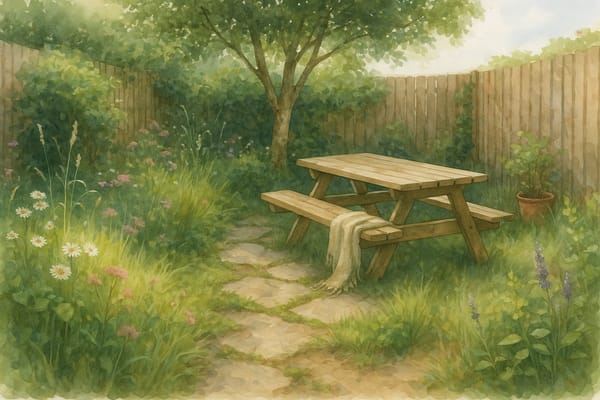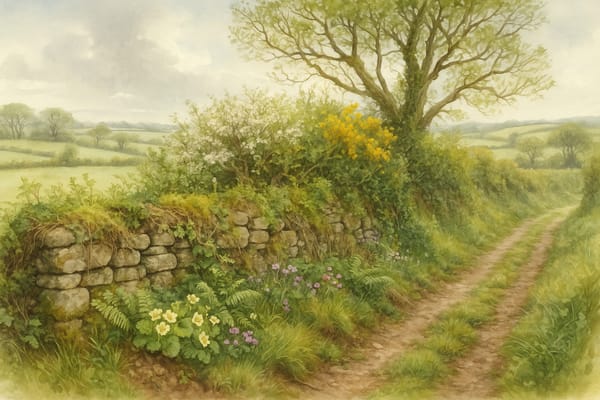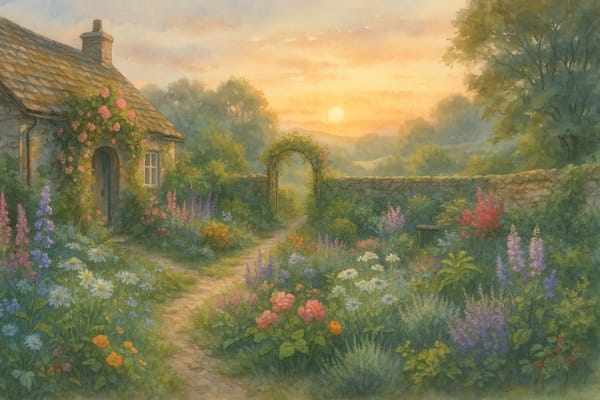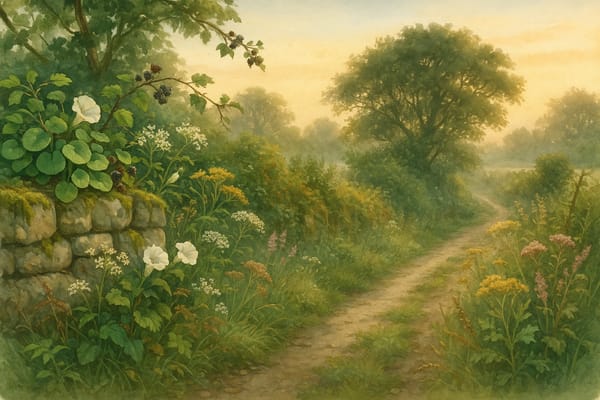There’s something timeless about the idea of a quiet picnic under the dappled shade of trees, surrounded by birdsong and the hum of bees. Yet in our pursuit of perfect lawns and manicured borders, many gardens leave little room for such tranquil, untamed corners.
But what if we let nature take the lead? What if the perfect picnic spot wasn’t a mown patch of grass or a formal bench, but a soft, living space where wildflowers grow, birds find refuge, and time slows down?
Welcome to the world of wild picnic spots — informal, wildlife-rich corners designed for peaceful retreats and gentle encounters with nature.
Finding Your Wild Corner
The best wild picnic spots feel hidden, even if they’re close to home. A quiet nook beneath a spreading tree, a sunny patch by a hedgerow, or the edge of a meadow can all become restful sanctuaries.
Blend Light and Shade: Choose a place that offers both — enough sun for warmth, enough shade for coolness on hot days. Woodland edges or spots near tall grasses offer a natural mix.
Design with Diversity in Mind: A variety of plants and habitats — open grass, shady understory, damp spots near a water source — attracts a wider range of wildlife and creates a layered, inviting feel.
Setting the Scene: Natural Features and Soft Touches
The beauty of a wild picnic spot lies in its casual charm — a space that looks effortless yet hums with life.
- Wild Planting: Scatter native wildflowers, plant hedgerow shrubs, or allow self-seeded species like foxglove, campion, and herb robert to thrive naturally.
- Water for Wildlife: A small pond, a half-barrel, or even a stone bowl of water draws birds, frogs, bees, and dragonflies — adding sound, life, and a sense of calm.
- Natural Seating: Logs, flat stones, or a rustic bench invite you to linger without dominating the space.
- Wildlife Havens: A log pile, stone heap, or thick shrubbery doubles as a natural sculpture and a refuge for insects, amphibians, and small mammals.
Wild Pathways and Subtle Boundaries
A winding path — perhaps just a mown strip through long grass — encourages exploration without disturbing the wild heart of the area.
- Soft, Curved Paths: Mimic natural animal trails to blend with the landscape and encourage wildlife movement.
- Informal Boundaries: Mark the space with low hedges, woven willow fences, or tall wildflowers, creating a sense of enclosure without fencing nature out.
Enhancing the Atmosphere for Relaxation
Your wild picnic corner isn’t just a haven for wildlife — it’s a sanctuary for you.
- Natural Soundscapes: A gentle water feature, wind chimes, or rustling grasses add soothing background sounds.
- Scented Planting: Include fragrant plants like lavender, honeysuckle, or night-scented stocks near your seating area.
- Soft Furnishings: Earthy picnic blankets, cushions, or a weathered throw transform a patch of grass into a restful retreat.
- Gentle Lighting: Discreet solar lights or fairy lights make evening picnics magical without disrupting nocturnal wildlife.
Creating a Haven for Wildlife
| Feature | Wildlife Benefit |
|---|
| Wildflower-rich grass | Nectar for pollinators, seeds for birds |
| Native shrubs and hedges | Shelter, food, nesting spots |
| Log/stone piles | Refuges for insects, amphibians, small mammals |
| Water feature | Drinking, bathing, breeding habitat |
| Dead stems and seed heads | Winter shelter for insects, food for birds |
Letting some areas grow wild, avoiding chemical treatments, and planting for year-round interest helps create a space buzzing with life.
Keeping It Wild — But Welcoming
Wild corners thrive on gentle neglect, but a little thoughtful care ensures they stay healthy and inviting.
- Seasonal Maintenance: Leave seed heads through winter. Lightly tidy in late winter to prepare for spring visitors.
- Minimal Intervention: Keep access paths clear but avoid over-pruning or mowing.
- Watch and Learn: Quiet time spent observing your wild corner can guide you on small improvements — a new water source, a patch of spring bulbs, a log added for cover.
Wild Comforts for the Perfect Picnic
- Eco-Friendly Picnic Gear: Natural materials — baskets, beeswax wraps, wooden plates — enhance the experience and reduce environmental impact.
- Flexible Seating: Low stools, picnic mats, or a simple log bench allow you to follow the sun or shade.
- Respectful Eating: Leave no trace — and consider plant-based, unprocessed treats that won’t harm local wildlife.
Blending Privacy with Nature
Natural barriers like mixed native hedges, tall wildflowers, or living willow screens can turn your picnic spot into a secluded retreat — all while providing habitat for birds and insects. Pair soft screening with winding paths and layered planting for a cocooned, peaceful feel.
Creating Pathways That Welcome Wildlife
Soft, curving paths lined with native plants offer both beauty and biodiversity. Allow hedgehog gaps in fences, edge paths with wildflower margins, and link habitat zones together. These thoughtful features make your wild corner a true crossroads for garden wildlife.
Where Wild Meets Welcome
A wild picnic spot isn’t about perfection — it’s about connection. Connection with nature, with the changing seasons, and with a gentler way of being outdoors.
By allowing a corner of your garden or green space to flourish informally, you invite both beauty and biodiversity into your life. These spaces ask little but give much: a quiet refuge, a place to breathe, and the joy of sharing your picnic with the silent flutter of wings or the curious gaze of a hedgehog.
And perhaps, in creating a place for nature to pause, you’ll find you pause more often too.











